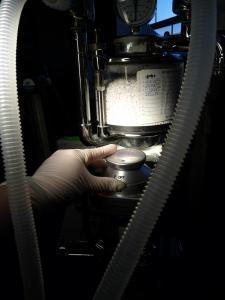How Risky is Anesthesia for my Pet?
- posted: Mar. 11, 2018
 Addressing Anesthesia Concerns
Addressing Anesthesia Concerns
One of the biggest concerns we hear from our clients are fears about their pets undergoing anesthesia. Sedation and anesthesia can be scary. What if something happens to your pet? What are the risks and how often do things really go wrong? Losing a pet under anesthesia is devastating not only for owners, but also for the veterinary team. This week, we will discuss some of the changes that may occur while your pet is under anesthesia and what our veterinarians and technicians do to keep your pet as safe as possible during surgery.
So, how much of a risk is anesthesia to your pet? The risk of a pet dying under anesthesia is very low—0.1 to 0.2% or 1 to 2 pets in 1000. Things that may increase the risk of something going wrong include body condition—very heavy or very small pets may have an increased risk—underlying illness, especially liver or kidney disease, and breed differences in tolerance or drug metabolism such as with short-nosed breeds or sighthounds.
What, exactly, can go wrong under anesthesia? The most common risks include low blood pressure, arrhythmias, vomiting/regurgitation/aspiration pneumonia during the post-operative period, blindness or deafness in cats and dysfunction of the cerebellum which controls basic life functions such as breathing and heart rate. Our veterinarians and technicians monitor these parameters very carefully during anesthesia and surgery.
Your pet has her blood pressure, heart rate, oxygenation, breathing and temperature closely monitored while under anesthesia. Nearly all pets undergoing anesthesia have an intravenous catheter placed to allow life-saving drugs to be given should they be needed and patients over the age of five will be given intravenous fluids as well to keep them hydrated and to help keep their blood pressure normal. All pets undergoing anesthesia also have a brief physical exam and all have some type of pre-anesthetic bloodwork done to ensure the pet is healthy or as healthy as possible. If changes are present, we can make adjustments to the type of drugs used or take other measures to combat any health risks before , during and after anesthesia.
Things can go wrong during recovery as well. Patients are closely monitored in the first 30-60 minutes after anesthesia to ensure that their body temperature is increasing, that they are breathing normally and that they are recovering and able to sit up on their own.
While we can never make anesthetic risk zero, the vets and surgical/anesthesia team at Patton Veterinary Hospital are dedicated to making every procedure as safe as possible for your pet. If your pet has had problems with certain drugs in the past, had a rough recovery or had some other adverse reaction, we want to know. We understand how worrisome it is to have a pet undergoing anesthesia and we share your concerns. We do not take these procedures lightly. If you have specific questions or concerns about your pet’s anesthesia, please do not hesitate to speak to one of the vets or technicians before the procedure. We know what a big deal anesthesia and surgery is, and we appreciate that so many of you trust us with your pets.
This blog brought to you by the Patton Veterinary Hospital serving Red Lion, York and the surrounding communities.
Source: Englar, Ryane E. and Wendy S. Myers. “Taking the Fear out of Anesthesia.” Veterinary Practice News Volume 30. Issue 1 (January 2018): pp. 16-17.
Location
Patton Veterinary Hospital
425 E Broadway
Red Lion, PA 17356
